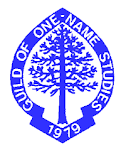The following post is a bit of a cheat, because it is actually an article I wrote which appeared in the December 2006 edition of the Leicestershire & Rutland FHS Journal. However, the reasoning behind the article remains sound. Please note that I am now back at college two nights a week, and forgive me for any shortcomings in the number of posts made.
In Praise of Maiden Aunts or Why every family historian should have at least one! – A work in progress.
"The phrase ‘maiden aunt’ sounds terribly old-fashioned and Victorian, and fits in with those other similar phrases such as “left on the shelf” and “ape-leader”, and that word more familiar to a family historian, “spinster”.
She’s the end of the line, nowhere to go from here, or so it may seem. However, every family historian should search out and treasure their maiden aunts, both living and long gone. The chances are that she is the child that stayed at home and looked after her parents in their old age, and who carried on living in the family home; the one who accumulated and treasured family papers; the one who knew all the family stories. Just because she never got married doesn’t mean that the juicy bits of family gossip passed her by!
But the best thing is that, should you be fortunate enough to have a maiden aunt who left a Will, it is likely that she will have left various parts of her estate to various different branches of the family, male and female. And this is where your research benefits. Often, family heirlooms and other bits and pieces end up in with a family, which appears to have no connection with yours whatsoever, and that you know nothing about, because they were passed down to a niece or great niece, who married into a different family. Your maiden aunt’s Will might well give her female beneficiaries’ married names, and possibly their addresses!
These thoughts are what occurred to me a couple of years ago, whilst waiting for a lecture to start at the Federation of Family History Societies’ Conference at Loughborough in 2004. I had some documents with me, foolishly thinking that I might have the time to do some active research, and amongst those documents were some Wills.
The Wills included that of Sarah Saddington of Foxton, who died on 12 June 1906. She had written her Will on 30 November 1894, and added a codicil on 24 July 1899. Sarah was born circa 1820 in Great Bowden, the 11th and youngest child of John Saddington and Frances Goward. From the censuses, I already knew that she had spent most of her life keeping house for her elder brother, John, a blacksmith and coal dealer in Foxton, and a bachelor who had died in 1889, leaving her his entire estate.
When I first received Sarah’s Will from the Probate Registry, I had read through it and copied the relevant information onto one of the useful forms previously supplied by Allen and Todd. Then I put it to one side. It wasn’t until I was flicking through my folder before the lecture at Loughborough when it occurred to me that, although I knew exactly who all the men mentioned in the Will were and how they fitted into the family tree, I could only identify two of the eight women listed as beneficiaries. This was a serious failing on my part, so I set out to track down Sarah’s nieces.
The women listed (in the same order as in the Will) were Sarah Rusby (niece), Elizabeth Saddington (wife of Thomas Saddington), Ann Archer (niece), Mary Farthings (niece), Ann Taylor (niece), Sarah Warton (niece), Fanny Laxton (niece) and Fanny Cooper (great niece).
I already knew that Elizabeth Saddington (nee Smith) was the wife of Sarah’s nephew, Thomas, also mentioned in the Will, and the eldest son of Sarah’s eldest brother, Thomas, my 3x great grandfather, and his wife, Hannah Deacon. I also knew that Ann Archer (nee Saddington) was the younger of Thomas Saddington the elder’s two daughters. But who were the other six women, and whose daughters were they?
Two years down the line, I know that Mary Farthing, Fanny Laxton and Sarah Wharton are the daughters of Joseph Saddington and Mary Lawrance; Joseph being Sarah Saddington’s youngest brother, and only 4 years older than her. I also have a fairly solid theory that Sarah Rusby is actually Sarah Busby (nee Lewin), and the daughter of Hannah Saddington and Benjamin Lewin of Wellingborough, Northants; Hannah being the eldest of Sarah’s five sisters. As to the final two, Ann Taylor may also be a daughter of Joseph Saddington and Mary Lawrance; they baptised a daughter called Ann in 1848. But Fanny Cooper still remains a mystery, for the time being.
So what have I learned so far?
I have learned that even your maiden aunt doesn’t necessarily know how to spell your married name; that it is easy to lose someone, even on the 1881 census, if their unexpected and unfamiliar birthplace is transported to a different county (Gilmorton in Worcestershire, anyone?), and that, even after 20 years research, the chances are that there are still things about your family history that you don’t know.
Two generations and fifty years down the line, Sarah Saddington’s great niece, Emily Ann Saddington, spinster daughter of Thomas Saddington and Elizabeth (nee Smith) left a Will, which mentioned seven nieces and a great nephew! Didn’t I say that every family historian should have at least one maiden aunt!"
Subscribe to:
Post Comments (Atom)

No comments:
Post a Comment